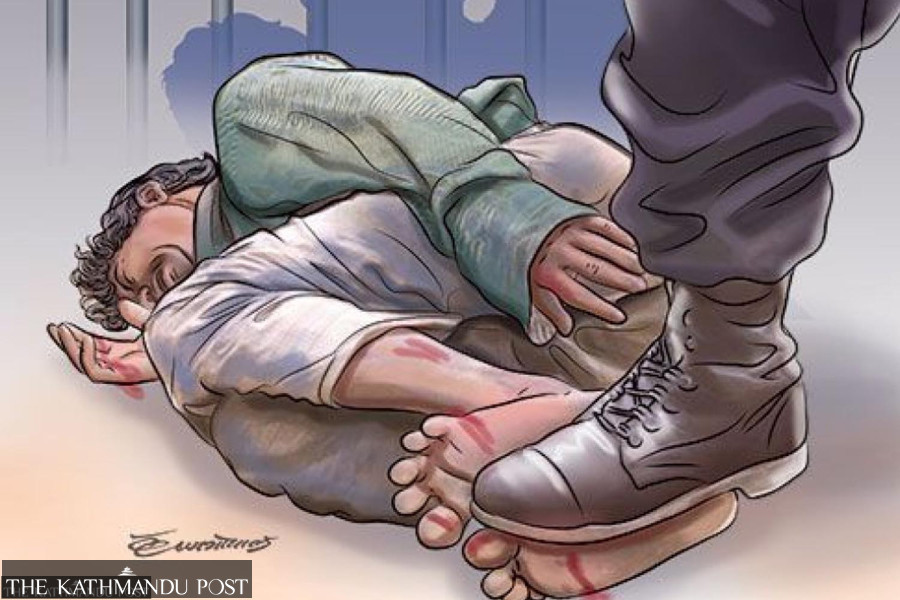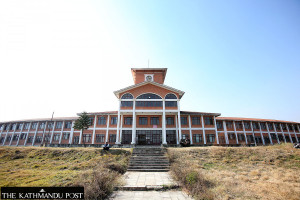Editorial
Justice in chains
Rising incidents of torture in judicial custody are inhumane and unconstitutional.
Incidents of custodial torture, though on the rise, remain largely neglected in Nepal. Just last month, a banking fraud convict—found unconscious in Kailali district jail following his arrest—died during treatment at Seti Zonal Hospital. The alleged torturer, a sub-inspector, has been arrested, but he is unlikely to face charges given the country’s history in granting clean chits to perpetrators. Such practices have so normalised custodial deaths that even though the National Human Rights Commission recommended prosecuting 16 cases in the last fiscal year—following 55 investigations related to complaints of torture—not a single one was executed. Likewise, despite the 2018 enactment of the Nepal Penal Code, no convictions have been made to date. This points to a serious disregard for the anti-torture law and the rights of inmates, and a clear violation of the constitutional prohibition of torture.
Data from the Advocacy Forum-Nepal, an organisation advocating for human rights, paints a bleaker picture: In 2024 alone, at least 10 incidents of torture were reported in police custody. The corresponding figure stood at 109 between 2018 and 2023. However, the actual numbers could be much higher, as torture against inmates is often concealed or dismissed by labelling them ‘mysterious’, ‘natural,’ or ‘suicide’. The Office of the High Commissioner for Human Rights (OHCHR) acknowledges that deaths in custody are “frequently underreported or go unrecognised and unreported.” In our context, the culture of impunity has sustained mainly because police officers are tasked with investigating their fellow officers.
Torture is strictly prohibited not only by Nepal’s constitution and the National Penal Code (2017) but also by the United Nations Convention Against Torture (UNCAT), which Nepal ratified in 1991. There are also legal provisions, including up to five years’ prison. Yet poor implementation of such laws has further emboldened the perpetrators. It has been found that poor, innocent people from marginalised communities are more prone to extrajudicial killings. The case of Sundar Harijan, who was imprisoned and tortured for a crime he didn’t do, and who later allegedly committed ‘suicide’ following immense physical and psychological abuse in 2022, is a troubling example.
Nepal needs an urgent course correction in how it treats its inmates. This begins with holding police officers involved in such crimes accountable, so they can no longer evade judicial processes and protect their colleagues engaged in extrajudicial killings. Regardless of the legal status of those incarcerated, the police and prison authorities must act responsibly and humanely with them. Separately, the Supreme Court directed the government to establish a new body to examine allegations related to custodial deaths in 2020, but nothing has been done to date. An impartial and independent investigation could be a stepping stone in mitigating extrajudicial killings.
In light of the recent case, two human rights organisations—Amnesty International Nepal and Advocacy Forum—issued a joint statement on Wednesday, pointing to successive governments’ failure in managing custodial torture and deaths. They have not only recommended the authorities to amend the Penal Code and align it with international human rights law and standards. They have also highlighted another serious issue—the code’s provision of a statutory limit of six months in reporting abuses, and recommended its removal. Heeding these concerns, among others, is vital for a policy-level overhaul in the country’s criminal justice system. Most importantly, implementing the existing anti-torture law is as necessary. Torture and death at the hands of those who are meant to protect people’s lives are unacceptable in a civilised society.




 19.12°C Kathmandu
19.12°C Kathmandu












%20(1).jpg&w=300&height=200)

